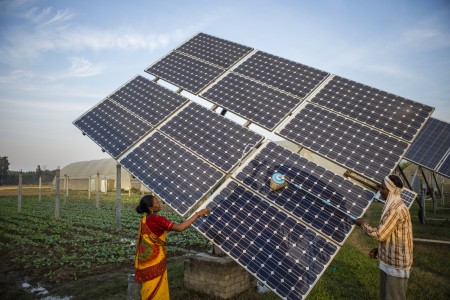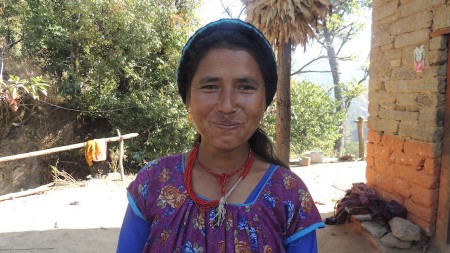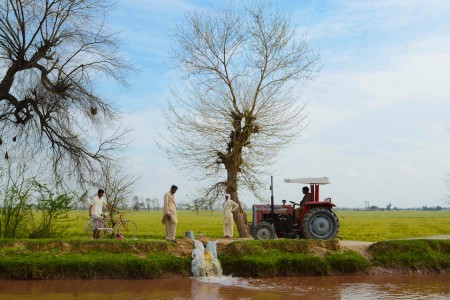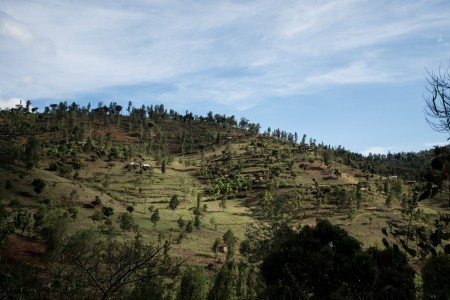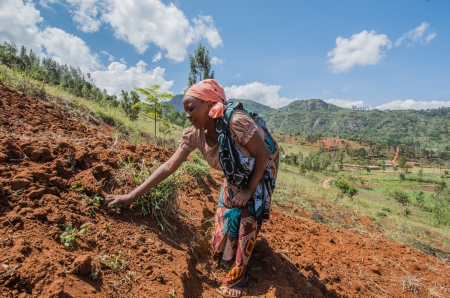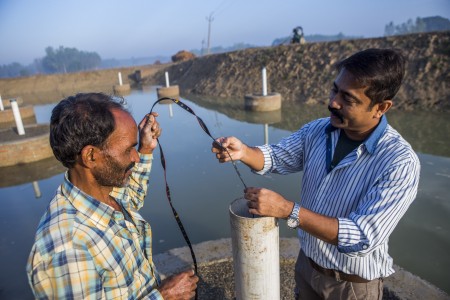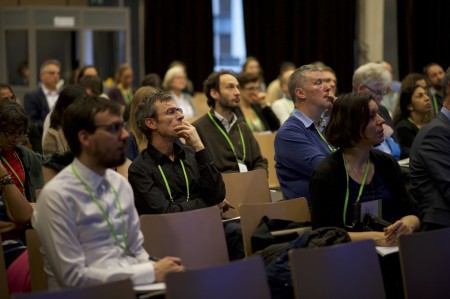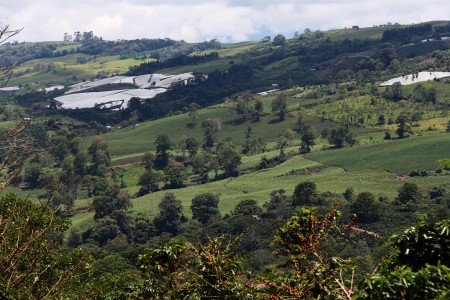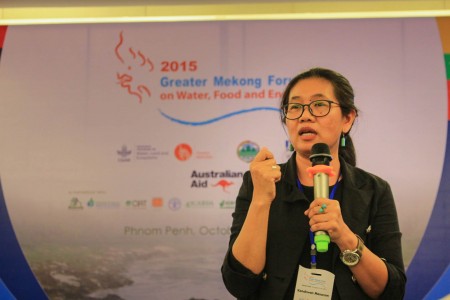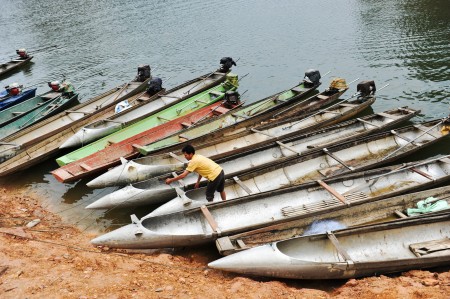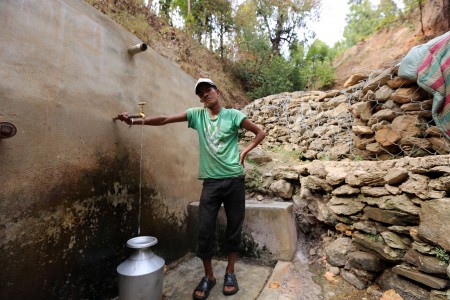The WLE 2015 Annual Report > Solutions for sustainable intensification of agriculture

Solutions fit for farmers and ecosystems can help double food production
The Sustainable Development Goal (SDG) on zero hunger is a top priority on the international agenda, and eliminating hunger globally is naturally and inevitably tied to farming. Therefore, the SDGs have set a target to double agricultural production by 2030.
Doubling production in less than 15 years requires wide-scale transformation of food production systems. Since 80 percent of food consumed in large parts of the developing world is provided by 500 million small farms worldwide, innovations will need to be suitable and profitable for smallholder farmers.
At the same time, growing pressure on ecosystems and natural resources necessitates that such new solutions—whether institutional, social, biological or technological—be sustainable. The CGIAR Research Program on Water, Land and Ecosystems and its partners are testing new innovations and technologies that support efforts to increase food production, improve livelihoods and enhance ecosystems.
Access to information facilitates adaptation, reduces conflicts
Technologies that increase farmers’ access to information are proving to be effective in strengthening their incentives to adopt new, more efficient and more sustainable farming practices. Information allows farmers to make smart, low-risk choices, enabling them to produce more food while spending resources more efficiently.
In Ghana and Ethiopia, scientists are testing “wetting front detectors,” a soil moisture measuring device that helps farmers to irrigate less. These are small tubes buried in the soil that contain a calibrated float; when the soil reaches a certain level of moisture saturation, the float rises, making it easy for farmers to tell when their fields have been sufficiently watered.
So far, wetting front detectors are proving successful in maintaining or even increasing crop yields while reducing irrigation frequency, consequently saving time, labor costs and precious water resources.

“In the past, we have experienced that farmers, especially the poorest and most vulnerable, have been unable to take up new practices, such as irrigating less,” explains Jennie Barron, co-leader of WLE’s Sustainably Increasing Land and Water Productivity theme. “Access to information that provides greater certainty about a new practice can be a tipping point for farmers, giving them sufficient confidence to change.”
Information sharing has also proved an effective strategy for reducing conflicts over water. This is the case in Pakistan, where farm productivity is affected by an imperfectly designed irrigation canal system. Particularly as the population grows, the canals no longer deliver an adequate amount of water for each farm plot. This has led farmers to believe that the canals are unfairly managed.
In order to test this theory, scientists introduced a simple technology for recording water levels along canals. Each day, data is collected, analyzed and translated into useable information by a computer software. Notices about the amount of water received along the canal are posted in the area weekly, allowing farmers to see that, while the canals may be inadequate, they are fairly managed. This, in turn, has reduced conflicts over water and provided incentives for increased cooperation.
New technologies increase yields, save resources and effort
In other cases, innovative technologies themselves reduce the amount of both labor and resource inputs required, thus making production more efficient.
For example, the development of an affordable, small, new plough has made it much easier for resource-poor smallholders in the Nile Delta to adopt raised-bed farming, which conserves water and soil. Scientists working with farmers to test the plough are reporting remarkable results, including a 25 percent saving in applied water, a 25 percent decrease in farming cost and a 15 to 25 percent increase in crop yields.
One farmer in the Nile Delta, Abdullah Sheikh, said: “For a thousand years, my family has been working the land the same way - flooding fields and planting seeds by hand. But this machine saves us much labor, seeds and effort." By using the raised-bed plough, Sheikh has nearly doubled the yields of his two acres of wheat, while using about a third less water. The plough is being put into use all over Egypt, as well as to other countries in the region such as Ethiopia, Eritrea, Iraq, Jordan, Morocco, Nigeria, Uzbekistan and Sudan.

In Kenya, Uganda and Ethiopia, biofertilizers are being tested as an alternative or complement to chemical fertilizers. Biofertilizers such as rhizobia inoculants are cost effective and environmentally friendly. These natural-occurring microorganisms are intentionally multiplied and added to a carrier material like peat. Adding these kinds of biofertelizers not only boost yields, but also increase soil fertility by fixing nitrogen in soils, increasing crops’ uptake of nitrogen, or both.
National and international agricultural research institutes across sub-Saharan Africa have been working with farmers and local businesses to establish markets and enabling policy frameworks for biofertilizers. In 2015, about 15,000 smallholder farmers used biofertilizers on their farms, which increased their yield and, by extension, food security.
“Globally, the greatest opportunity for reaching the SDG on zero hunger is to invest in smallholder farmers’ role in transforming food production systems. This is where we have opportunities for production increases as well as water, land and labor productivity gains,” says Barron. “The gap we have to overcome has nothing to do with farmers’ willingness to change, but everything to do with researchers’ ability to make knowledge and innovations accessible for the transformation.”
Acknowledgments
The solutions presented in this article have been developed by the following projects:
- Enhancing Ecosystems Services through Dialogue led by the International Water Management Institute
- Innovation Lab for Small-Scale Irrigation in Sub-Saharan Africa led by the Texas A&M in collaboration with International Water Management Institute, the International Livestock Research Institute and the International Food Policy Research Institute and funded by the US Government initiative on Feed the Future
- A fact-checking approach towards strengthening evidence-based policy and technology implementation in the Nile Delta led by the International Center for Agriculture Research in Dry Areas
- Institutionalization of quality assurance mechanism and dissemination of top quality commercial products to increase crop yields and improve food security of smallholder farmers in sub-Saharan Africa – COMPRO-II led by the International Institute of Tropical Agriculture and funded by the Bill and Melinda Gates Foundation. Read more about the project’s WLE-specific activities.
Agriculture 2.0:
towards a global revolution
for sustainabilitywater, land and ecosystems research highlights
2015 – 2016
A message from Johan RockströmWLE Steering Committee Chair
Agriculture 2.0
Current farming practices use 70 percent of the Earth’s fresh water, degrade 40 percent of land and contribute to 30 percent of greenhouse gas emissions.
But there is a better way: putting sustainability at the center of our food systems will not only reverse climatic degradation, but also accomplish the productivity that is necessary to feed 9 billion people by 2050.Sustainability is not just a necessity. It is an untapped opportunity for improving the livelihoods of male and female smallholders farmers, ensuring the productivity of the land into the future, and better harnessing the services provided by our ecosystems.
The CGIAR Research Program on Water, Land and Ecosystems (WLE) is doing its part to make the sustainable intensification of agriculture a reality by producing evidence-based solutions for water and land management via partnerships that span nationalities, sectors and disciplines.
We invite you to explore highlights from WLE’s work below.
in 2015 wle: field tested 62 technologies and natural resource management practices, helped 125,000 farmers to apply new technologies or management practices, supported improved technologies or management practices on 2.5 million hectares
Solutions for sustainable intensification of agriculture
In 2015 WLE: established 41 multi-stakeholder platforms and influenced 200 policy processes
Engaging with the global agenda
Practical approaches to regional problems
WLE in 2015 had 110,000 website visits and 43,000 views on CG-space and published 141 ISI publications and 94 open access publications
